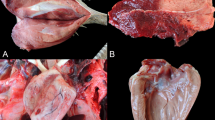Abstract
Data from post-mortem and field studies were obtained that discussed poisoning in ostriches following ingestion of toxic plants. From the notes, all plants studied caused death in ostriches and there was systemic organ damage. Poisoning from Sarcostemma viminale (Melktou) resulted in beak patting, muscular tremors and head flopping, followed by collapse and violent kicking before death. Ingestion of Combretum oatesii (Red wings) seeds from plants in free grazing pastures resulted in vomiting, restlessness, eyelid flicking, collapse and kicking movements. Dichapetalum cymosum (Gifblaar) killed an ostrich after episodes of shaking legs, rapid respiration and bradycardia and hyperaemia of the lungs, liver and kidneys. Poisoning from Senecio sceleratus (Ragwort) caused skin haemorrhages and bleeding in tracheal mucous membranes, the pericardium, diaphragm and interperitoneal membrane. Consumption of drupes from Melia azedarach (Syringa berry) caused muscle tremors, kicking movements and respiratory distress. Lantana camara (Cherry pie) poisoning resulted in extremely inflamed eyes with copious yellow exudates extending down their beaks and onto their necks. Bentonite was administered by gavage at a dose of 5 g/kg. Poisoning in these cases is usually associated with the farmer allowing his/her birds to roam free-range in paddocks in which toxic plants are growing. Toxic plants should be removed from grass cut for hay.
Similar content being viewed by others
References
Araya, O., Hernandez, J.R., Espinoza, A.E. and Cubillos, V., 1983. Serum changes and histologic liver lesions due to experimental ingestion of ragwort (Senecio erraticus) in sheep. Veterinary and Human Toxicology, 25(1), 4–7.
Craig, A.M., Pearson, E.G., Meyer, C., Schmitz, J.A., 1991. Serum liver enzyme and histopathologic changes in calves with chronic and chronic-delayed Senecio jacobaea toxicosis. American Journal of Veterinary Research, 52(12), 1969–1978.
del Mendez, M.C., Elias, F., Aragao, M., Gimeno, E.J. and Riet-Correa, F., 2002 Intoxication of cattle by the fruits of Melia azedarach. Veterinary and Human Toxicology, 44(3), 145–148.
Gopinath, C. and Ford, E.J., 1977. The effect of ragwort (Senecio jacobea) on the liver of the domestic fowl (Gallus domesticus): a histopathological and enzyme histochemical study. British Poultry Science, 18(2), 137–141.
Hare, W.R., Schutzman, H., Lee, B.R. and Knight, M.W., 1997. Chinaberry poisoning in two dogs. Journal of the American Veterinary Medical Association, 210(11), 1638–1640.
Kandel, A. and Chenoweth, M.B., 1952. Tolerance to fluoroacetate and fluorobutyrate in rats. Journal of Pharmacology and Experimental Therapeutics, 104(2), 248–252.
Minnaar, P.P., McCrindle, R.I., Naude, T.W., Botha, C.J., 2000. Investigation of biological samples for monofluoroacetate and Dichapetalum cymosum poisoning in southern Africa. Onderstepoort Journal of Veterinary Research, 67(1), 27–30.
Msami, H.M., 1999. An outbreak of suspected poisoning of cattle by Dichapetalum sp. In Tanzania. Tropical Animal Health and Production, 31(1), 1–7.
Pass, M.A., McSweeney, C.S. and Reynoldson, J.A., 1981. Absorption of the toxins of Lantana camara L. from the digestive system of sheep. Journal of Applied Toxicology, 1(1), 38–41.
Sharma, O.P., Makker, H.P. and Dawra, R.K., 1988. A review of the noxious plant Lantana camara. Toxicon: Official Journal of the International Society on Toxinology, 26(11), 975–987.
Shlosberg, A. and Egyed, M.N., 1975. Fluoroacetamide (1081) poisoning in wild birds. Journal of Wildlife Diseases, 11(4), 534–536.
Shone, D.K. and Drummond, R.B., 1965. Poisonous Plants of Rhodesia, (Ministry of Agriculture and National Resources Board of Rhodesia, Salisbury, Rhodesia).
Watt, J.M. and Breyer-Brndwijk, M.G. (1962) Plants of Southern and Eastern Africa. E. & S. Livingstone Ltd., London. pp.1457.
Author information
Authors and Affiliations
Corresponding author
Additional information
The author is willing to send photographs of all poisonous plants if requested by a reader.
Rights and permissions
About this article
Cite this article
Cooper, R.G. Poisoning in ostriches following ingestion of toxic plants - field observations. Trop Anim Health Prod 39, 439–442 (2007). https://doi.org/10.1007/s11250-007-9044-y
Received:
Accepted:
Published:
Issue Date:
DOI: https://doi.org/10.1007/s11250-007-9044-y




